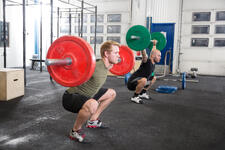Strength Training with Hyper-mobile Joints

Many swimmers exhibit the common characteristics of athletes who have spent the majority of their athletic development in the water. In particular, hyper-mobile joints are advantageous in swimming, but can be detrimental to strength training on land if the athlete is not mindful of the tendency to hyperextend or hyper-rotate these joints. There is a concern for injury when athletes who have hyper-mobile joints reach their end range of motion during weightlifting because the body is not maximally stable in these extreme positions. This can lead to strains and tears in the joint tissue. Let’s discuss how to recognize hyper-mobile athletes and how they can strength train in a safe and effective manner.
What does a Hyper-mobile Joint look like?
Swimmers generally have hyper-mobile ankles, knees, hips, elbows, and shoulders. Did I miss anything? The point is swimmers become very limber and flexible around joints they use due to the repetitive nature of swimming. Ankles become loose from the repetitive flexion and extension of kicking, hips gain greater range of motion from the undulations in butterfly and breastroke, and shoulders hyper-rotate from the repetitive circling of the arm in every stroke. Swimmers even create micro-tears in their shoulder joint to meet the demand for greater mobility in their strokes; these small tears are asymptomatic and simply increase the joint range of motion. However, an increase in joint mobility can be accompanied by a decrease in joint stability, leaving these areas at a higher risk of injury. Knees and elbows tend to hyperextend based on genetics more than training. Knees and elbows help swimmers be more propulsive in their kick or their catch, respectively, because they can move more water past the normal angle of the joint.
When identifying a hyper-mobile athlete, analyze one joint at a time. Swimmers will often have excellent toe point from their flexible ankles. Check the knees by having the athlete stand up straight. Observe from the side or profile of the athlete. If their legs bow inward when locked, meaning the knees are set back while the hips advance forward, then the athlete can hyperextend that joint. Check elbows by having the athlete straighten his or her arms. If the forearm advances past a straight line and into a crooked position when locked out, the elbows hyper-extend. Most swimmers will have hyper-mobile shoulders.
Emphasize Technique
Protect hyper-mobile joints by emphasizing proper technique. Hyper-mobile athletes must pay even greater attention to detail during each of their exercises in the weight room. For example, make sure the knees do not cave inward toward the midline of the body during a simple squat. This is a natural tendency for those with hyper-mobile hips and weak glute muscles, and it can lead to knee pain. The elbow joint is most at risk during pressing exercises, such as bench press or pushups. A hyper-extended elbow puts more stress on the wrist in these loaded positions and sets the athlete up for a hyperextension injury during heavy lifting. The same goes for the knees. Never lock out your legs during lower body exercises. Leave a slight bend in the knee even during triple extension movements to maintain a stable base. Pay particular attention to the angle of your arm during upper body movements. Some swimmers are so hyper-mobile in the shoulder that they over-reach and over-rotate in strength exercises on land, which can lead to pain and injury.
Emphasize Stability
In your strength training, master bodyweight exercises first before attempting heavier loads. Implement stability exercises for at risk joints. For example, monster walks will activate the glute muscles and stabilize the hip and knee. Stabilizing the shoulder requires the use of very light weights (2 lbs is plenty) or bands for minimal resistance as you move through various arm motions. Check out our Bridge Shoulder Exercises to get started on your stability training. Core strength will also boost your stability in any plane of motion so be consistent with your core exercises as you work through your strength training.
Hyper-mobility can be advantageous yet risky. Working on your stability throughout the season not only protects you from injury, but it also allows you to move confidently and smoothly through your strength training. This will maximize your strength gains from each exercise. For more information on the biomechanics of swimmers on land, check out this post here. With these tips in mind, you are well on your way to a successful strength regimen!
Related Posts

The Best Bench Press Variation You’re...
This post is part of our Coaches Corner series with Taylor Rimmer. Taylor is NSCA-CPT, StrongFirst...

Does Powerlifting Harm Heart Health?
A recent study has discovered that a 12-week supervised strength training program (SSTP) may result...

Barefoot Running: Is It For You? |...
Run Free: Consider Less Cushion
Updated October 2020:
With more athletes looking for ways to...
.png?width=150&height=50&name=BRIDGEBLOG(1).png)

